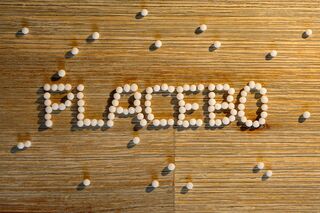Placebo
Mind Over Matter: The Power of Placebo
Don't dismiss the placebo effect as self-deception.
Posted January 27, 2022 Reviewed by Vanessa Lancaster
Key points
- Placebo effects are genuine physiological and cognitive shifts, similar to or greater than the results of “real” interventions.
- Placebos impacts a dazzling breadth of areas, and they can work even when recipients know they’re getting placebos.
- The placebo effect has implications for our everyday lives, including improving moods, boosting energy, and building good habits.

The placebo effect is the phenomenon of our expectations resulting in real physical and mental changes. It has frustrated, intrigued, and perplexed researchers at least as far back as the 1700s.
More recently, placebos have been found to impact a dazzling breadth of areas such as pain, nausea, asthma, erectile dysfunction, blood pressure, speed, strength, endurance, depression, focus, and phobias.
Here are just a few fascinating examples:
- Luana Colloca and team found that patients whose painkillers were given to them without their knowledge needed twice as much of the drug to get the same effect.
- Surgeon Bruce Moseley gave half of his patients real arthroscopies (knee surgery) and the other half placebo surgery. He found that the fake surgery worked as well as the real surgery in more than half of his 50 trials.
- Christina Draganich and Kristi Erdal made participants think they had gotten more sleep than they did. This false belief improved their performance on language and math tests.
- Liron Rozenkrantz and team told participants that sniffing a special odor would boost their creativity, even though it was merely a placebo smell. After sniffing the scent, participants demonstrated greater creativity.
How do placebos work?
It’s important to note that the impacts of placebos are not imaginary. It’s not a matter of lying to ourselves or pretending to see results that aren’t there. Placebo effects are genuine physiological and cognitive shifts – similar to or greater than the results of “real” interventions.
As a case in point, researchers Jon Levine, Newton Gordon, and Howard Fields gave patients in pain either morphine (a strong painkiller), a placebo, or naloxone (a drug that blocks the endorphins that morphine triggers). They found that naloxone blocked the painkilling effect of placebos, demonstrating that placebos release actual endorphins in the same way that a drug like morphine can.
So, what makes these sci-fiesque mind-over-matter results possible? While the placebo’s underlying mechanisms are still a bit of a mystery and likely a combination of multiple factors, here are two leading explanations:
- Conscious expectations (AKA the confirmation bias plus self-fulfilling prophecy): when we anticipate something, we look for small hints that confirm our beliefs. The more evidence we gather, the stronger our beliefs become, and the more closely our expectations approach reality. For example, You take a piano lesson and are told that you are naturally gifted. Now each time you practice, you notice how quickly you learn, which builds your confidence, which makes you learn even faster.
- Unconscious expectations (AKA classical conditioning): when a stimulus is paired repeatedly with a response, just the sight, smell, or even thought of the stimulus can trigger the response. For example, Your manager has complained about your work several times, causing your stress levels to rise. Now just the sound of their voice saying “good morning” makes your stomach hurt and your palms sweat. There is no actual threat in their greeting, but your body prepares for more criticism.
A fascinating twist? The placebo effect occurs even when you know it’s a placebo – a phenomenon known as the ‘open placebo’ effect. This research is relatively nascent, but researchers have already found that open placebos successfully alleviate symptoms for people with irritable bowel syndrome, back pain, and hay fever. The familiar act of taking a pill alone might be enough for many to see positive changes.
How can we make placebos work for us?
Most people view the placebo effect as either frustrating or fascinating, but what if we could put placebos to good use beyond the confines of the laboratory? After all, if no trickery is required for placebos to do their magic, why not find ways to placebo ourselves? So, without further ado:
Here are six strategies to harness the power of the placebo in your everyday life:
- Partner with your placebos: If there’s something you do that skeptics question, whether it be chromatherapy or acupuncture, don’t worry too much about whether these solutions are “proven” to work. As long as they are safe and affordable, placebo research shows us that what works is what works for you.
- Act “as if”: This concept comes from relationship therapist Michele Weiner-Davis, who encourages kicking off a positive chain of events by pretending that it’s already begun. Are you dreading your workout? For just a few minutes, act as if you’re really looking forward to it. Are you trapped in a boring conversation? Act as if you’re fascinated. This strategy lets you shift your expectations manually – no pills needed.
- Dwell on what’s working: While it’s important to acknowledge and address our negative feelings, it’s also incredibly easy to dwell on what’s going wrong. Just by deliberately shifting our attention to the positive, we can build on what’s working. For example, researchers Alia Crum and Ellen Langer found that people who were told they got exercise just by doing their regular jobs actually burned more calories and lowered their blood pressure without changing their daily activities.
- Connect with the why: Placebo research reveals the extent to which our beliefs shape our reality. One way to leverage this phenomenon is to deepen our beliefs around why the things we do are important. For a burst of motivation, pause to ask yourself why the thing you’re doing matters, whether it’s your work, your art, your fitness rituals, or time spent with loved ones. The clearer that “why” feels, the greater return you’ll see on the time you invest.
- Create (elaborate) rituals: Another way to trigger the placebo effect is to train yourself into unconscious associations through classical conditioning. Pair two things over and over until your brain expects one thing to follow the other. In other words: create rituals. For example, if you have a hard time falling asleep – spray lavender mist into the air right before you get into bed. Do this over and over again until the mere scent of lavender makes you sleepy. Placebo research shows us that the more elaborate the placebo, the stronger the effect. Four placebo pills have a larger effect than two, and placebo injections are more effective than placebo pills. So, for best results, make your rituals elaborate or unusual. Perhaps adding a gesture, word, song, or special pillow along with that lavender mist will get you sleeping even faster.
- Prescribe a magic “pill:” Perhaps the strangest (yet still effective) strategy on this list is to simply prescribe yourself a placebo to achieve your desired result. Decide on something (safe) you’ll eat, drink, do, or wear to signal that you’re entering a certain state. For example, a single blueberry can become your focus pill. A hat turned backward can be your creativity pill. A tug on your earlobe can become your empathy pill. Odd as it sounds, pairing the action and the intention again and again will function as your very own open placebo.
Placebo effect research is an important illustration of the vast potential of our minds. Placebos are not a replacement for validated medical interventions. But in a society that trains us to believe that our happiness depends on everything from pills to cosmetics to shopping sprees, placebos remind us how much power exists within us.
This article summarizes research and ideas from the Placebo & Nocebo Effect episode of our podcast, Talk Psych to Me.
References




